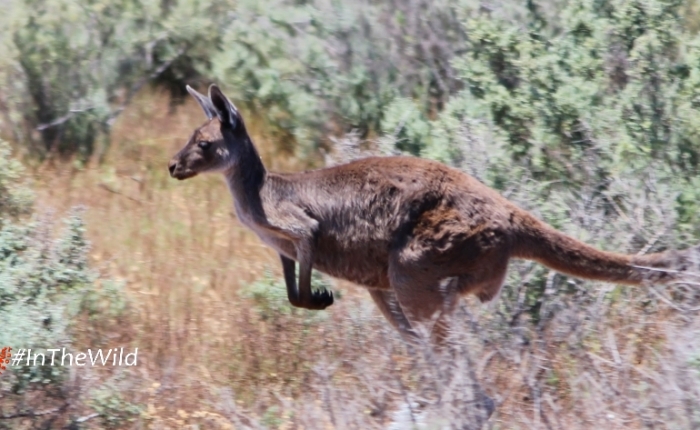<a href=”http://www.bloglovin.com/blog/4324549/?claim=h3axrsb9c2e”>Follow my blog with Bloglovin</a>
Koalas are connected to everything!

In nature, everything is connected. But some of the affinities between koalas and other animals might surprise you!
Honeyeaters, like this Eastern Spinebill, pollinate trees. Without honeyeaters, new trees will struggle to grow. No trees = no koalas.
If Flame Robins didn’t eat insects, plants would suffer from insect overpopulation. Insects eat the leaves of many plants, eucalyptus included. Too many insects = no leaves on trees for koalas to eat.

Even butterflies are important to koalas. Butterflies, like this Common Brown, pollinate native plants when they search for nectar to drink. Unlike bees, who pollinate a small area very effectively, butterflies can carry pollen large distances, which means they can bring new plants to an area and ensure an even spread of a diversity of plants. Plant diversity at the ground level helps other animals like wallabies thrive.

Caterpillars, the babies of butterflies, eat plants. The caterpillar of the Common Brown eats grasses like Kangaroo Grass (Themeda triandra), which has a tendency to become too dominant in an area if not managed. Aboriginal People managed kangaroo grass with regular small fires, but now that is not happening, we are lucky to have Common Brown caterpillars!
Macropods (kangaroos, wallabies) make tracks through thick undergrowth as they search for food and water. When the undergrowth is thick, koalas use the tracks of kangaroos and wallabies to move around from tree to tree every day. If there are no tracks through thick undergrowth, a koala is in danger of predation by dogs, and they find it much harder to push through. Too much energy expended means a koala has less energy to breed.

Grass-seed eaters, like Long-billed Corellas, spread the seeds of grasses and help control weeds like Onion Grass. Grassy woodlands are perfect habitat for koalas, providing easy movement from tree to tree.

Koalas also benefit other species. Black-chinned Honeyeaters are a threatened small bird. They take fur from koalas to line their nests. Without koalas, who will the Black-chinned Honeyeaters get fur from? Wallabies don’t stay still long enough, possums are only out at night. Will baby Black-chinned Honeyeaters get too cold in their nests and die?
Some creatures, like this Painted Honeyeater, have almost disappeared from koala habitat. Could this be why koalas are declining? We just don’t know.

People often ask us why koalas are declining, even in National Parks. Truth is, no-one is really sure. Every region has different challenges, but overall, koalas are declining too rapidly for their long-term survival.
We don’t know the answer to koala decline, but we do know this: everything is connected. When Grey-crowned Babblers disappeared from the You Yangs, did that affect koalas? Maybe only slightly. When Tasmanian Pademelons, Eastern Barred Bandicoots, Brush-tailed Rock-wallabies and Dingoes disappeared did that affect koalas? Slightly+slightly+slightly+slightly = a lot.
Fact is, we have lost insect, bird, reptile and plant species that koalas rely on from koala forests, yet we still expect koalas to breed well (but not too much) and live long healthy lives. It is amazing that they are surviving at all.
The mammals of Victoria, Australia
Full List of Mammals of Victoria, Australia
Victoria has 103 native extant (living) mammal species. They represent 28 families in 8 orders. Victoria comprises only 3% of Australia’s total area, but is home to nearly 30% of her mammals. Most of the major types of Australian mammals are present in this state: 2 of the 2 monotreme families; 11 of the 17 living marsupial families; 6 of the 8 bat families; 1 of the 1 family of native rodents and 8 of the 10 families of marine mammals.
Conservation Status in Victoria is noted beside each species thus: CR: Critically Endangered EN: Endangered VU: Vulnerable NT: Near Threatened DD: Data Deficient
MONOTREMES: Order Monotremata (2)
Family: Ornithorhynchidae (1)
Ornithorhynchus anatinus (Platypus)
Family: Tachyglossidae (1)
Tachyglossus aculeatus (Short-beaked Echidna)
MARSUPIALS: Infraclass Marsupialia (38)
Order: Diprotodontia (24)
Kangaroos, wallabies: Suborder Macropodiformes (9)
Family: Macropodidae (7)
Macropus fuliginosus (Western Grey Kangaroo)
Macropus giganteus (Eastern Grey Kangaroo)
Macropus robustus (Eastern Wallaroo) EN
Macropus rufogriseus (Red-necked Wallaby)
Macropus rufus (Red Kangaroo)
Petrogale penicillata (Brush-tailed Rock-wallaby) CR
Wallabia bicolor (Swamp Wallaby)
Family: Potoroidae (2)
Potorous longipes (Long-footed Potoroo) EN
Potorous tridactylus (Long-nosed Potoroo) EN
Koala & wombat: Suborder Vombatiformes (2)
Family: Phascolarctidae (1)
Phascolarctos cinereus (Koala)
Family: Vombatidae (1)
Vombatus ursinus (Common Wombat)
Possums & Gliders: Suborder Phalangeriformes (13)
Family: Acrobatidae (1)
Acrobates pygmaeus (Feathertail Glider)
Family: Burramyidae (5)
Burramys parvus (Mountain Pygmy Possum) CR
Cercartetus concinnus (Southwestern Pygmy Possum) NT
Cercartetus lepidus (Tasmanian Pygmy Possum) NT
Cercartetus nanus (Eastern Pygmy Possum) NT
Gymnobelideus leadbeateri (Leadbeater’s Possum) CR
Family: Pseudocheiridae (2)
Petauroides volans (Greater Glider)
Pseudocheirus peregrinus (Common Ringtail Possum)
Family: Petauridae (3)
Petaurus australis (Yellow-bellied Glider)
Petaurus breviceps (Sugar Glider)
Petaurus norfolcensis (Squirrel Glider) EN
Family: Phalangeridae (2)
Trichosurus caninus (Mountain Brushtail Possum/Bobuck)
Trichosurus vulpecula (Common Brushtail Possum)
Bandicoots: Order Peramelemorphia (3)
Family: Peramelidae (3)
Isoodon obesulus (Southern Brown Bandicoot)
Perameles gunnii gunnii (Eastern Barred Bandicoot) CR
Perameles nasuta (Long-nosed Bandicoot)
Dasyurids (carnivorous mammals): Order Dasyuromorphia (11)
Family: Dasyuridae (11)
Antechinus agilis (Agile Antechinus)

Antechinus flavipes (Yellow-footed Antechinus)
Antechinus minimus (Swamp Antechinus)
Antechinus swainsonii (Dusky Antechinus)
Dasyurus maculatus (Tiger/Spot-tailed Quoll) EN
Ningaui yvonneae (Southern Ningaui) NT
Phascogale tapoatafa (Brush-tailed Phascogale) VU
Planigale gilesi (Giles/Paucident Planigale) NT
Sminthopsis crassicaudata (Fat-tailed Dunnart) NT
Sminthopsis leucopus (White-footed Dunnart) NT
Sminthopsis murina (Slender-tailed/Common Dunnart) VU
PLACENTALS/EUTHERIANS: Infraclass Placentalia (63)
Order: Carnivora (8)
Suborder: Caniformia (8)
Family: Canidae (1)
Canis dingo (Dingo) DD
MARINE MAMMALS: (33 in two orders)
Seals: (7)
Family Otariidae (4)
Arctocephalus forsteri (New Zealand Fur Seal) VU
Arctocephalus pusillus (Cape/Australian Fur Seal)
Arctocephalus tropicalis (Subantarctic Fur Seal)
Neophoca cinerea (Australian Sea Lion)
Family: Phocidae (3)
Hydrurga leptonyx (Leopard Seal)
Lobodon carcinophaga (Crabeater Seal)
Mirounga leonina (Southern Elephant Seal)
Whales & Dolphins (Cetaceans): Order Cetacea (26)
Suborder: Mysticeti (8)
Family: Balaenidae (1)
Eubalaena australis (Southern Right Whale) CR
Family: Balaenopteridae (6)
Balaenoptera acutorostrata (Minke Whale)
Balaenoptera borealis (Sei Whale) DD
Balaenoptera edeni (Bryde’s Whale) DD
Balaenoptera musculus (Blue Whale)
Balaenoptera physalus (Fin Whale) DD
Megaptera novaeangliae (Humpback Whale) VU
Family: Cetotheriidae (1)
Caperea marginata (Pygmy Right Whale)
Suborder: Odontoceti (18)
Family: Delphinidae (8)
Delphinus delphis (Short-beaked Common Dolphin)
Globicephala melas (Long-finned Pilot Whale)
Grampus griseus (Risso’s Dolphin)
Lagenodelphis hosei (Fraser’s Dolphin)
Orcinus orca (Orca)
Pseudorca crassidens (False Killer Whale)
Tursiops australis (Burrunan Dolphin) EN
Tursiops truncatus (Bottlenose Dolphin)
Family: Physeteridae (2)
Kogia breviceps (Pygmy Sperm Whale)
Physeter macrocephalus (Sperm Whale)
Family: Ziphiidae (8)
Hyperoodon planifrons (Bottlenose Whale)
Mesoplodon bowdoini (Andrews’ Beaked Whale)
Mesoplodon densirostris (Blainville’s Beaked Whale)
Mesoplodon ginkgodens (Ginkgo-toothed Beaked Whale)
Mesoplodon grayi (Gray’s Beaked Whale)
Mesoplodon layardii (Layard’s Beaked Whale)
Mesoplodon mirus (True’s Beaked Whale)
Ziphius cavirostris (Cuvier’s Beaked Whale)
Bats, Fruit Bats, Flying foxes: Order Chiroptera (20)
Flying Foxes: Suborder Megachiroptera (2)
Family: Pteropodidae (2)
Pteropus poliocephalus (Grey-headed Flying-fox) VU

Pteropus scapulatus (Little Red Flying-fox)
Micro-bats:
Suborder Microchiroptera (17)
Family: Emballonuridae (1)
Saccolaimus flaviventris (Yellow-bellied Pouched Bat)
Family: Molossidae (2)
Mormopterus planiceps (Southern Free-tailed Bat)
Tadarida australis (White-striped Free-tailed Bat)
Family: Vespertilionidae (14)
Chalinolobus gouldii (Gould’s Wattled Bat)

Chalinolobus morio (Chocolate Wattled Bat)
Falsistrellus tasmaniensis (Eastern False Pipistrelle)
Miniopterus schreibersii (Common Bentwing Bat) EN
Myotis macropus (Large-footed Bat)
Nyctophilus geoffroyi (Lesser Long-eared Bat)
Nyctophilus gouldi (Gould’s Long-eared Bat)
Nyctophilus timoriensis (Greater Long-eared Bat) VU
Scotorepens balstoni (Inland Broad-nosed Bat)
Scotorepens orion (Eastern Broad-nosed Bat)
Vespadelus baverstocki (Inland Forest Bat)
Vespadelus darlingtoni (Large Forest Bat)
Vespadelus regulus (Southern Forest Bat)
Vespadelus vulturnus (Little Forest Bat)
Suborder: Yinpterochiroptera (1)
Family: Rhinolophidae (1)
Rhinolophus megaphyllus (Smaller Horseshoe Bat) VU
Native rats and mice: Order Rodentia (9)
Family: Muridae (9)
Hydromys chrysogaster (Water Rat)
Mastacomys fuscus (Broad-toothed Mouse) DD
Notomys mitchellii (Mitchell’s Hopping Mouse) NT
Pseudomys apodemoides (Silky Mouse) NT
Pseudomys fumeus (Smoky Mouse) CR
Pseudomys novaehollandiae (New Holland Mouse) VU
Pseudomys shortridgei (Heath Mouse) NT
Rattus fuscipes (Bush Rat)
Rattus lutreolus (Australian Swamp Rat)
This list has been compiled from Wikipedia: http://en.wikipedia.org/wiki/List_of_mammals_of_Victoria and The Museum of Victoria: http://museumvictoria.com.au/bioinformatics/mammals and the Atlas of Living Australia: http://www.ala.org.au
If any mammals are missing, please contact janine@echidnawalkabout.com.au
What’s In The Bush – Part 2: Birds
Downunder is on top, for birds anyway!
This world map is upside down, because this really is the right way up when it comes to birdlife.
This infographic shows the distribution of the large birds of the world (not including the geese & swans, which are worldwide). As you can see, large birds have a predominantly southern distribution.

The world’s biggest birds – Ostriches – can only be seen in Africa. Their similarly enormous relatives, Emus & Cassowaries, can only be seen in Australia/New Guinea. In fact, all of the ratites (those mentioned, plus kiwis, rheas & tinamous) are only found in the Gondwana continents – Australia, New Zealand, South America & Africa.
The next largest in weight, the penguins, are only found in southern waters except for one – the Galapagos Penguin. The huge ones – the Emperor & King Penguins – only live around Antarctica. Smaller members of the family live as far north as southern Australia, South Africa and up the west coast of South America.
The heaviest flying birds, the bustards, have two representatives in Europe, and three in central Asia, but by far the largest diversity of the family is in Africa – Africa has 19 species of bustard. India has another three, South-east Asia and Australia both have one species each.
Pelicans are very large birds that range widely. Seven of the eight species live in the Gondwana continents. Two of those range into Europe (Great White, Dalmatian), and another one ranges into North America (Brown). The only one that doesn’t live in the south – the American White Pelican – lives in North America and winters in Mexico.

For an excellent table of the world’s heaviest birds see this link: http://en.wikipedia.org/wiki/Largest_organisms#Birds_.28Aves.29
In terms of wing span, the largest birds are the albatrosses. The great albatrosses, the Wandering and Royal Albatrosses, can have wingspans up to 3.7 metres. Albatrosses have a primarily southern distribution. Of 22 species*, 18 are restricted to the southern oceans.

Vultures, both Old World and New World (which are not closely related to each other) have very large wingspans to 3metres. North America has three species, and Europe has four, but Africa has ten species, India and South America have six species each. Again, the great diversity of these two families is in the Gondwana continents.

In addition, the ‘charismatic’, well-known bird families of the world also live mostly in the southern continents. Birds of Paradise, Bowerbirds, Lyrebirds live only in Australia/New Guinea/South-east Asia; Toucans & Quetzals live only in South & Central America. Parrots are at their greatest diversity in Australia, and almost all the species worldwide live in the southern continents. Cockatoos only live in the Australia/New Guinea/SE Asia region.
Even some of the best known of European birds – pigeons, herons, storks & cranes – actually have many more species in the south than in the north.

But why?
Because Gondwana – and Australia in particular – is where most of them began! In his amazing book “Where Song Began” Tim Low outlines what ornithologists have known for years: the southern continents have stocked the world with birds.
Even the songbirds – the canaries, finches, sparrows, larks, warblers, mockingbirds, thrushes, blackbirds, robins, shrikes, orioles, cardinals, flycatchers, kinglets, wrens and chickadees – have all come from Aussie ancestors.
So next time you hear a wonderful dawn chorus, say thanks to our little continent at the bottom of the world (or the top, depending on how you look at it!!)
*debate continues on the number of species of albatrosses – some say as few as 13 exist, others believe 24. This number based on IUCN and BirdLife International.
What’s in The Bush? An overview of Aussie & New Zealand wildlife. Part 1: Mammals
So what’s wrong with this view? Or rather, what’s right with it?
Now you’re Downunder, everything is upside down.
Our mammals lay eggs, our reptiles care for their babies, birds are flightless but mammals fly, and Orion does a headstand in the starry sky.
You’ll meet our mammals, birds and reptiles. You’ll see how many of them live in female-dominated and matriarchal societies. Many of them breed communally too. Its all part of living Downunder!
So to begin – The continents in red & orange on the map above are our sisters. We are the “Gondwana continents” and we are special.
The ‘Gondwana sisters’ have nearly all the special mammal families of the world. These animals are found nowhere else.
Aussie has some of the biggest and most charismatic of them – kangaroos, koala, wombat, Tassie Devil, gliding possums, platypus, echidna, bilby, numbat and others. Seriously, these animals, in fact their whole families, are found nowhere else on earth. You have to go upside down to see them in the wild….

This is a male Eastern Grey Kangaroo – the world’s largest marsupial. They can grow to 7ft tall and weigh 90kg (200 pounds). But don’t be fooled by his size and power. It’s the girls who rule here.
These animals discovered the extended female-dominated family. They were doing it long before humans came up with the idea. To watch a mob of roos interact – the female majority all interested in each other’s welfare, getting along nicely most of the time with the occasional disagreement quickly solved by a slap. In the background some males fight over breeding rights, but the females ignore them.

Here’s a kangaroo family. Two males (left and back) but don’t worry about them, as I said they don’t count. It’s the two females in the centre that matter.
The girl in the middle, carrying a big pouch-baby – she is a Kangaroo Queen. She is the daughter, and grandaughter of Queens too.
One way a mob starts is this: a female is born who is super-intelligent, strong, adventurous and has a talent for mothering. Her name is “Sunshine”
Sunshine, for whatever reason, strikes out to find a land of her own. A male finds her and 35 days later she has her first child. A daughter. Its always a daughter. She made sure of that. (Yes, kangaroos can determine the sex of their offspring)
Sunshine teaches her daughter everything she knows, and that’s a lot – remember she’s the daughter of a Queen. Her daughter stays close to her mum, because that’s what most kangaroo females do, for their whole lives. Sunshine has other daughters (there’s one in her pouch now), and her daughters have daughters. They all stay together, loving and close – most of the time.
When Sunshine has a big enough family to keep watch for danger, and provide her with company when she’s old, she finally has a son. Why does she wait so long? Because her son will leave, and kangaroo mothers hate losing their children. He has to leave. He leaves when he gets to breeding age because there’s no sex here – all the females in his mob are his aunties, sisters & close cousins!! And kangaroos just don’t do that!

Also in the You Yangs mountains near Melbourne live these guys. This is Clancy, and you can read about him on his Facebook page.
Koalas are more cute than words can describe. But like a lot of really cute people, appearances are deceiving.
You are looking at one of the toughest creatures on the planet.
I’d like to see any human tough guy climb a slippery gum tree, all the way to the top – 30m/100 ft in the air. Then balancing with his feet only, reach out to grab leaves on branchlets far too fine to carry his weight. Then eat them – yuk. Fair dinkum, those leaves taste awful! They’re the equivalent of the Atkins Diet without the protein… or fat.. or vegies…. There’s no such thing as a fat koala!!
So after Mr Tough Guy has eaten his Atkins leaves he has to sit there and digest. It takes hours. He’d like a sip of water, but he can’t have it. Meanwhile the sun has risen, and from a pleasant night-time temperature of 8 degrees C, the temperature rises to a sweltering 42 Celsius. In one day. He can’t come down from his tree – it’s unsafe on the ground, and he hasn’t got the energy. So he has to sit it out.
Koalas and Polar Bears have the world’s most insulating fur. The conditions they suffer are similar – koalas on the hot side, polar bears on the cold side.
I don’t think many humans would last long in Clancy’s shoes.

Somehow, with all these challenges koalas have survived for 37 million years.
Once again, the ladies dominate. She lives 1.5 times longer than him. She chooses her mate. She keeps her daughters close their whole lives, but her sons leave for other female-dominated communities.
But they face their biggest threat now – climate change is adding insult to the injury of habitat loss. They are already the toughest, but there’s only so much a mammal can take.

Speaking of ancient mammals – this is one of the oldest in the whole world!! Platypuses, and echidnas, come from a line that is 120 million years old! That is older than some rocks I know!
Mating is initiated by the female, who swims alongside the male seductively until he gets the message.
These spiny darlings – Echidnas – lay eggs, but they are still mammals.
Mammals have hair – even whales have some hair. Mammals also feed their young on milk produced from glands. So Echidna are still mammals, even though they lay eggs.
Their egg is leathery and hatches 10 days after laying. Mother echidna curls up in a ball and lays the egg straight into her pouch – amazing!
The baby, named a puggle, stays in the pouch after hatching, drinking milk from glands on the mothers belly. But when he gets spines, he gets kicked out! And fair enough too!

In Aussie we also have a dazzling array of wallabies, rock-wallabies, bettongs, potoroos, wombats, and the cutest possums in the whole world!
But its not all about marsupials and monotremes down here – we also have fabulous placental mammals! I’ll explain more about what that means in the second presentation: Sex in the Bush!
NZ and Aussie have lots of beautiful Seals, Sea Lions, Dolphins and Whales. I recommend that you include a visit to the coast when you’re in our countries.
Next week I’ll post part 2 of this presentation: Birds!
What’s in The Bush was first delivered to around 400 guests on Olivia Cruising Australia & New Zealand 2015, on Holland America’s Oosterdam Cruise Ship. The presentation was one hour, including questions. I am available to give this presentation for groups – please contact janine@echidnawalkabout.com.au
Endemic mammal families of the world: Part 1 Australasian Ecozone
In Australia, we grow up knowing that most of our mammals are found nowhere else on earth. We almost take that for granted, but it really is an incredible legacy!
But which mammal families are endemic to Australia? Which are endemic to Australia+New Guinea and their islands? Which are endemic to the region east of the Wallace Line (incl Sulawesi, New Guinea, Australia)?
How does our level of endemism compare to other great continents? Please forgive the upside down map – this is the way I see the natural world!
In researching for some cruise ship presentations I found this information hard to come by. So here’s a few lists I’ve put together from my own research. There may be some gaps or errors – if you know of any, please let me know!
Australasian Endemic Mammal Families:
Tachyglossidae – Echidnas (endemic to Australia+New Guinea)
Ornithorhynchidae – platypus (Australia only)
Dasyuridae – Antechinuses, Quolls, Tasmanian Devil (Australia+New Guinea)
Myrmecobiidae – Numbat (Australia only)
Thylacomyidae – Bilbies (Australia only)
Peramelidae – Bandicoots (Australia+New Guinea)
Notoryctidae – Marsupial mole (Australia only)
Phascolarctidae – koala (Australia only)
Vombatidae – wombats (Australia only)
Burramyidae – pygmy possums (Australia+New Guinea & one species in indonesia close to West Papua)
Tasipedidae – honey possum (Australia only)
Petauridae – sugar glider, leadbeaters possum (Australia+New Guinea)
Pseudocheiridae -ringtails (Australia+New Guinea and several species in Indonesia close to West Papua)
Potoridae – potoroos (Australia only)
Hypsiprymnodontidae – Musky rat kangaroo (Australia+New Guinea)
Macropodidae – kangaroos (Australia+New Guinea)
Acrobatidae – feather-tailed glider & the feather-tailed possum (Australia+New Guinea)
Phalangeridae – brushtails & cuscus (Australia+New Guinea, and Sulawesi, Indonesia)
More to come: Endemic Mammal Families of Africa (African / Afrotropic Ecozone)!
References: Wikipedia species accounts
Burgman & Lindenmayer “Conservation Biology for the Australian Environment”
Australia is one of the world’s most diverse natural places!
The earth is a remarkable, exciting place, packed full of animals and plants. It is estimated that the world has 5,400+ mammals, 10.000+ species of birds, 10,000+ reptiles (and growing), 7,300+ amphibians, 950,000+ insects and around 310,000 species of higher plants.
But did you know that most of these can be found in 12 countries? These 12 are the Mega-diverse Nations (1).

Australia, Brazil, China, Colombia, Congo (DR Congo), Ecuador, India, Indonesia, Madagascar, Malaysia, Mexico, Peru together hold 60-70% of the world’s species.
Many of these nations are home to a host of endemic species – that is, species that occur nowhere else. Australia is home to 210 endemic mammals (5% of the world’s total), 355 endemic birds, 616+ endemic reptiles (nearly 10% of the world’s total reptiles) and 14,458 endemic plants.
Unfortunately, many of these countries are also on the UN list of the worst forest-clearing nations (2).

The worst land-clearing nations on earth are, in order (in bold are the countries that are also the mega-diverse nations):
Brazil, Indonesia, Sudan, Zambia, Mexico, Australia, Congo, Myanmar, Nigeria, Zimbabwe, Argentina, Peru, Cote d’Ivoire, Malaysia, Cameroon, Venezuela, Colombia, Bolivia, Ecuador and Angola.
Aussies, unlike most of these countries, we are a developed wealthy economy. Why are we still cutting down forest that is home to a world-class fauna and flora diversity??
Sources:
(1) Burgman & Lindenmayer “Conservation for the Australian Environment”
(2) United Nations Food and Agriculture Organization 2001, Forest Resources Assessment 2000,
UNFAO. Unfortunately I can’t find any information more recent than this. I have read that Australian rates of deforestation had reduced since this time, but have very recently increased again. Even so, as Australia is 6th on the list of 20, we would have to reduce deforestation greatly to get off this list.
Tourism Businesses: Nine top tips to make your business more eco-friendly (and make your clients happier!)
- Plastic is nasty. Almost every bit of plastic ever created is still in existence, much of it floating in the ocean. It never breaks down. Big bits of plastic end up in the bellies of baby Albatrosses and Dolphins, killing them through starvation. Small bits (micro-plastic) remain floating in the ocean, or sink to the seafloor. It is not known what effect these have, but marine scientists are concerned. Recycling plastic doesn’t help much – after one or two recycles the plastic becomes unusable gunk that goes to landfill. WHAT TO DO? Replace plastic with glass, bamboo, cornstarch-alternatives, metal, paper, cardboard. If you can’t find a plastic alternative that works for you, then reduce your plastic by using hard plastic reusable items.

toughened glass containers and reusable coffee mugs - Local is good. Local fruit & vegetables, anything bought from local-owned businesses, is much better for the planet than supporting a multi-national. You are making local jobs, usually reducing fuel from transport (both yours and theirs), and supporting your local community. Smaller businesses are often more able and willing to make eco-friendly changes to their practices, especially if they value your business.
- Support markets and independent grocers. I know, the supermarket giants seem convenient, but sometimes a local grocer is actually easier. South Melbourne Market is open every day except Monday, Tuesday & Thursday. They even have a sustainability and waste reduction policy. Our local greengrocer delivers our fruit to our door. The quality and freshness of food from the market far exceeds that bought from the big supermarkets. The fruit we buy from the market/greengrocer outlives the supermarket fruit by days – reducing waste and cost to the business.
- Fruit is the best snack ever! It comes in bio-degradable packaging all of its own. It is classy, healthy, suits everyone, varies with the seasons and if local, is exotic and special to your guests. People with food allergies can often eat fruit. Fruit is kosher. Kids love fruit, especially strawberries, bananas, watermelon and grapes. Of course, try not to buy it in a plastic bag or box – take your own ‘green bags’ to the market (see point 6) and your produce is packaged ready for storage and a long life.
- Disposable anything is wasteful and lacks class. I have felt offended when a ‘quality’ tour gives me lunch in a disposable plastic container with plastic cutlery. That’s not quality. That shows that a business is not prepared to wash dishes for the likes of you. On the flip side, we have so often been complimented by our guests for the proper crockery we serve our food on. Washing dishes is not hard – most businesses have dishwashers!
- ‘Green bags’ (Fresh Fruit Bags) extend the life of fruit & vegetables. They really, really do – we have a food technologist in the family and he’s confirmed it. We put everything in them – they keep cut avocadoes green, cut watermelon & canteloupe stays fresh for days, broccoli and lettuce last weeks. Yes, they are plastic, but we make an exception for these because they reduce food waste and are reusable many times. The pack says to use them three times only, but we wash and re-use them until they fall apart and we’ve seen no loss of quality. You can buy them online here: http://www.gelpack.com.au/freshcrisp.html
- Compost! If you’re using fruit and paper bags, it can all go into a compost bin. 95% of our tour waste goes into one 2litre compost bucket each day. The compost is stored at our city office for a week, then is collected and transferred to our country property where it fertilises native plants. If you don’t have a country place, look around for a community garden or group that could use your compost – they will probably collect it as well. This organisation supplies compost units to restaurants in Melbourne – you can be part of it here: http://www.closedloop.com.au/closed-loop-organics
- Vehicle washing does not need to use massive amounts of water. Buy one of the high-tech cleaning mitts (every supermarket and auto store has them, see pic) – you will be amazed at how well they work. Half a mop-bucket of water and a high-tech cloth cleans a Hiace 12 seater van inside and out. No need to rinse – once over with the mitt is all that’s needed. It’s quicker and much cheaper than taking the vehicle to a carwash, and you can do it at your base without flooding the joint. Think of the staff time (and money) you’ll save.

these car-cleaning cloths are excellent - Publicise your eco-friendly initiatives – you will make others think, and give your competitors a reason to do it too. Write it all up on your website so your potential clients can see it. Tweet, Facebook and Instagram it! Get your Guides to show off your compost bucket on tours. Put a sticker on your vehicles “I am washed with only half a bucket of water”. Your clients will talk about it, and anything that gets travellers talking about us after the tour is good for business!
This is not a post about how we are perfect – we are not. There are still aspects of our business that are not as eco-friendly as they could be. We are still learning. Do you have any tips? Please add them in the comments!
Tourism companies work together to save wild koalas
Insight Australia have become the first Inbound Tour Operator to join with award-winning wildlife tour operator Echidna Walkabout to make a home for a wild koala.
Insight Australia’s generous donation funds local people to remove thousands of weeds that are degrading wild koala habitat. Through research, Echidna Walkabout discovered that Boneseed weed makes gum-trees unavailable to koalas. Removing it ‘turns the trees back on’ for koalas, effectively increasing koala habitat immediately.

“Insight Australia Travel is a great believer in and supporter of sustainable tourism. Our travellers love the Australian experience much of which is about our beautiful wildlife. We jumped at the opportunity to support Echidna Walkabout firstly because we want to see Koalas’ truly thrive in the wild and secondly because our travellers strongly desire and fully appreciate the unique experience they offer. For tourists to be able to engage in such a manner and to be able to actually make a difference results in an inspiring win/win.“ Birgit Bourne, Insight Australia
“With this donation, we will run a Koala Conservation Day for Locals that will remove at least 5,000 weeds. That is the equivalent of planting 200 koala food trees. The effect on koalas is instant – they can move in and start feeding in the habitat the next day.”“ Janine Duffy, Echidna Walkabout Nature Tours.
Participants on the Koala Conservation Day come ready for a solid day of weeding, koala research and education. The Days are very popular with locals, and are often over-subscribed. Echidna Walkabout are keen to run more, so are seeking funding from Australian and international companies. Just $600 makes a home for a wild koala for a whole year.
“We encourage other Aussie companies to follow Insight’s lead and contribute to this productive project, either through donation or by organising their own Staff Conservation Day” says Duffy. ““It really does work – since starting this project we have seen an increase in koalas of 370%. Your donation really could save koalas from extinction”
For images: images library on Google+
Contact: Janine Duffy, Echidna Walkabout
T: +61 (0)3 9626 8249 M: +61 (0)427 808 747
E: janine@echidnawalkabout.com.au
Birgit Bourne, Insight Australia
T: +61 (0)2 9949 9669 M: +61 (0)422 417 978
Why do kangaroos hop?
You’d have to ask a kangaroo why they hop. Their answer (if you could understand roo) would possibly be “because my mum did”.
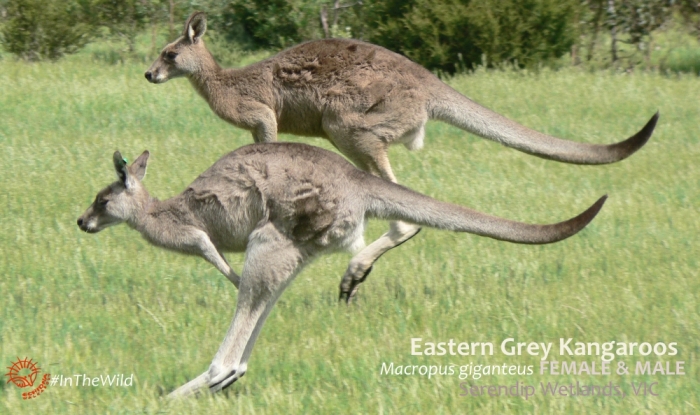
So, in the absence of roo input, here are some of the advantages of hopping:
1. Hopping is energy efficient.
This is probably the most important single factor. Hopping uses less energy than four-legged running at the same speed.
It is critical in a dry, unpredictable environment to be efficient with resources. Kangaroos sometimes have to travel long distances, in oppressive heat, with very little water to drink and poor food in their bellies. Most mammals would not survive.
See big mobs of Eastern Grey Kangaroos hopping on Sunset Koalas & Kangaroos IN THE WILD tour.

Kangaroos eat grass. Australian grasses can be fairly low in digestibility, and sparsely cover the ground. The grass dries off quickly, and during summer only the first few millimetres of the grass is green – the rest is dry and golden. So for the whole of summer (and sometimes longer in drought) adult kangaroos have to move around, socialise, breed, and feed their babies on a diet that wouldn’t feed a lamb. Food = energy. Hopping doesn’t use much food energy, compared to other forms of locomotion. So kangaroos can survive on their poor diet.
Like most grazers, kangaroos need to drink water daily. But in their country, surface water can be hard to find and unreliable. When the surface water dries up completely, they have to hop to better watering sites. Exertion depletes the body of water. So an efficient means of movement, like hopping, uses less precious water than other forms of movement.
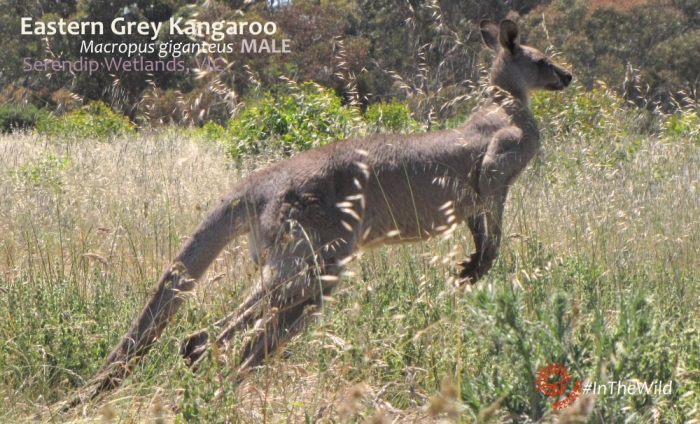
2. Hopping is quiet.
We can’t find any scientific research to support this, but it is our experience that kangaroos move extremely quietly compared to other animals. Maybe because they are in contact with the ground so little, or because their feet are soft (like a dog or cat’s), or maybe because they have only two feet to worry about they can place their feet carefully. Whatever the reason, a large mob of kangaroos can move very quickly without much sound at all, even through Bush full of sticks and dry leaves.
The stride length of a kangaroo hopping at speed is long – 6 metres at 50km/hr. That means they are only touching the ground 2 times a second. In contrast, a galloping horse touches the ground four times in each stride, and has a foot in contact with the ground at all times creating a constant drumming sound. At the same speed a horse touches the ground 8 times a second.
Why is this useful? Kangaroos’ natural predator is humans. Being able to escape quietly could mean the difference between life and death.
3. Hopping is flexible and allows for sudden changes of direction.
Kangaroos have an amazing ability to turn quickly! They can achieve a 180 degree turn in a single hop.
Hopping as a means of locomotion probably gives kangaroos an ability to turn “on a pinhead” which would be very useful for escaping predators. We don’t know of any terrestrial mammal that can turn as sharply as a macropod. With the centre of gravity at the pelvis, the kangaroo is a pivot that can almost turn on a point. Most land-based mammals have a long body, with their weight centred between the front and back legs. The length of the body limits the turning circle. In a way, they have to wait for their back legs to catch up. Also, the speed limits the turn – the faster they go, the harder it is for them to turn, and the more stress it puts on their legs, ankles and feet. We suggest that even at speed a kangaroo could turn very sharply without damaging their legs because most of the turn is executed while airborne.
Kangaroos live all over Australia, in grasslands, in mountains – hopping allows them to move quickly over any surface, no matter how rough, steep or uneven.

4. Kangaroos have evolved from possum-like ancestors who bounded along tree branches and the ground. Hopping could be just an adjustment on four-footed bounding.
Small macropods, like the Musky Rat-kangaroo, bound along the ground using their front feet a bit. Brushtail Possums can bound or run, and sometimes sit up on their back legs just like a small kangaroo. So it’s not hard to imagine the possum-like ancestors of kangaroos – bounding on the ground, running along branches. Over time they got bigger, moved into the grasslands where there were no branches to clamber along, and their ability to bound got them out of danger quickly. Over time their ability to run ceased altogether.
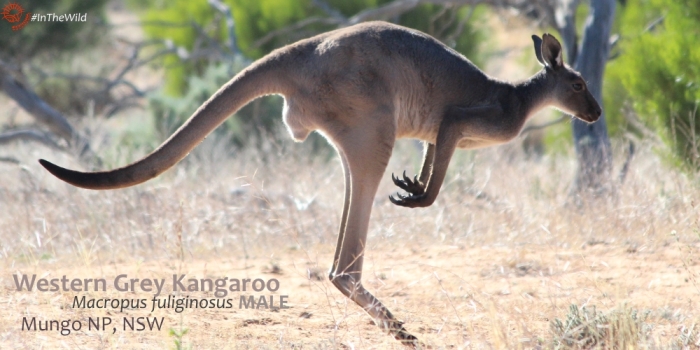
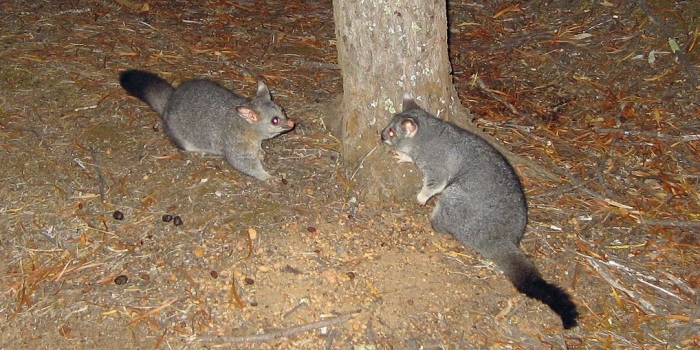
To see all this in action come on the Sunset Koalas & Kangaroos IN THE WILD tour near Melbourne, Australia.
Or see Red Kangaroos and Western Grey Kangaroos on the Mungo Outback Journey
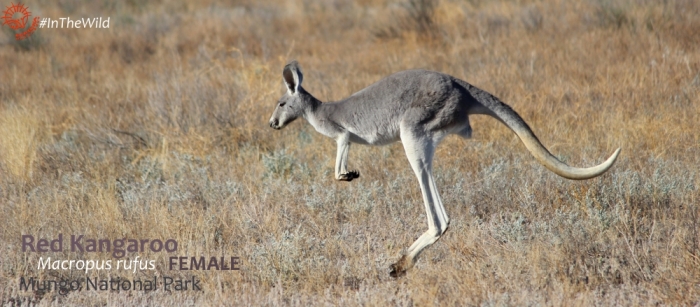
http://www.echidnawalkabout.com.au/tours/sunset-koalas-kangaroos/


